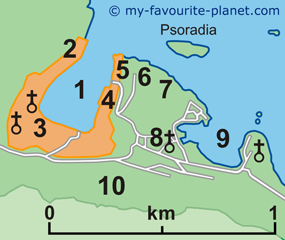Kastellorizo Archaeological Museum
Opening hours: Tuesday - Sunday 8.30 - 15.00 hours.
Mondays closed.
Tickets €2, reduced €1
Tel: +30 22460 49283
e-mail: efadod@culture.gr
Known as the "Konaki", the small fortress with crenellated battlements and courtyard were part of the Medieval Castle of Agios Nicholas (Άγιος Νικόλαος), in Kastellorizo's fortified precinct, just below the tower which is the only remaining part of the Knights' Castle. It was used by the Ottoman Turks as the governor's headquarters and a barracks.
During the French occupation it became a hospital, and was badly damaged by bombardment from the Turkish coast in 1917. The French restored the building, and further restoration was carried out by the Italians who once again used it as a barracks.
After World War II it remained abandoned until it was converted into a museum in 1984. Officially called the Museum of Megisti or Kastellorizo Museum (like just about everything on the island it has at least two names), it displays a small selection of archaeological finds of the Classical, Hellenistic and Roman eras, Byzantine pottery, a large icon of Saint George and the dragon as well as cultural artefacts such as a sponge diver's suit. Most remarkable are the very rare Lycian style votive reliefs.
The folk artefacts are exhibited at the Cultural Museum in the
Ottoman Mosque.
The "Megiste Ostothek"
The finest archaeological find from Kastellorizo is a small marble casket, either an ostothek (a container for a deceased person's bones) or a child's sarcophagus, thought to have been made in a workshop in Anatolia (Asia Minor) around 150-180 BC, during the Roman Imperial period. It is now in the National Archaeological Museum, Athens.
Referred to variously as the "Megiste Ostothek", "Megiste Sarcophagus", "Bellerophon Sarcophagus" or even "Megiste Casket", it is decorated on all four sides with reliefs depicting a mythological scenes. One side shows Aphrodite and Eros, and the hero Bellerophon with the winged horse Pegasus. The other side has scenes from Homer's Iliad: Odysseus, and Diomedes stealing the Palladion statue from the Trojans. On one of the ends is a depiction of drunken Herakles, and on the other a Centauromachy.
National Archaeological Museum, Athens. Inv. No. 1189.
Height 45 cm, width 90 cm, depth 43 cm.
| |

Map detail: Kastellorizo harbour
|
1 main harbour of Megisti
2 police station, post office, municipal hotel
3 Agios Georgios church, Nikolaos Stamatiou school, travel agent
4 ferry landing, harbour police, tourist information, bank, duty free
5 coast guard, mosque, path to Lycian tomb
6 Megisti museum, path to Lycian tomb
7 Knight’s Castle, Saints Nicholas & Dimitrios, hamam, windmill
8 Horafia, Platea Panagia, churches, Santrapeia school, Despina sculpture,Taverna Mediterraneo
9 Mandraki harbour and cemetery
10 stairs to clifftop view |